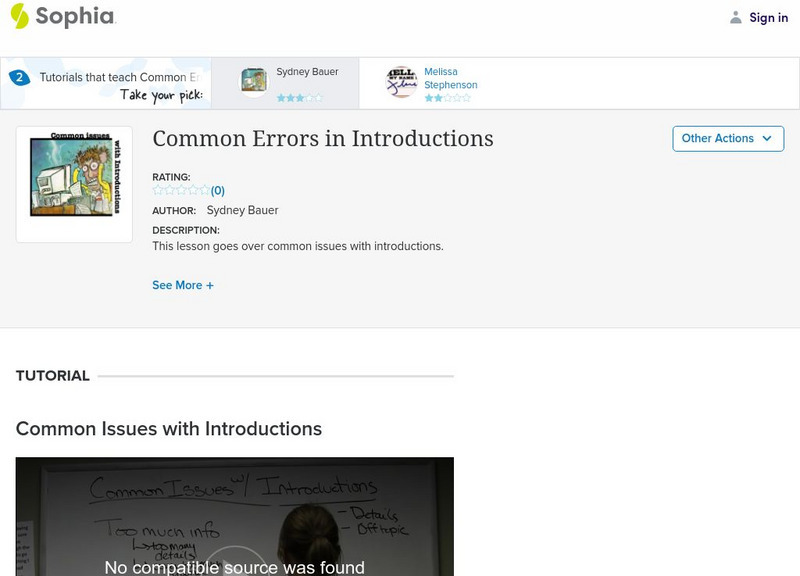PBS
Jane Eyre 3: The Governess
The third episode in the Masterpiece Jane Eyre series focuses on the episode in which Jane has been invited to bring Adele to meet Lady Ingram and her daughter Blanche. Viewers are asked to compare how the film and the novel convey...
Curated OER
Capturing Authentic Narratives
“Authentic narrative is the glue that connects people.” So says the narrator of this short video who models for young journalists how to craft the questions and identify the sources that will yield the information needed to create a...
TED-Ed
Three Anti-Social Skills to Improve Your Writing
"What?" she said. "That video just told me to eavesdrop, get to know imaginary people, and talk to myself. Interesting." It's all for a good cause, though! These three techniques will help your young writers improve their fictional...
TED-Ed
Slowing Down Time (in Writing & Film)
How do you slowmo a story? The narrator of a short video models how to slow down the pace of a narrative by using concepts drawn from slow motion filming. Just as slow motion in a film is achieved by speeding up the process so that more...
TED-Ed
The Case Against "Good" and "Bad"
Good and bad are put on trial for covering up the truth with vague descriptions. How dare they lie like that! See if the presenter can convince your class to ban these words and replace them with more precise, descriptive, and...
Sophia Learning
Sophia: Common Errors in Introductions
This video lesson focuses on writing introductions and common issues with introductions. It discusses the use of details and information -- too much or not enough and being off topic. It suggests using specific language in the...
Sophia Learning
Sophia: Narrative Key Elements
This video lesson focuses on the key elements of writing a narrative: point of view, tone, reflective statement, pacing, emphasis, and cohesion. W.9-10.3,3a, 3b, 3c, 3e Narratives, W.11-12.3,3a, 3b, 3c, 3e Narratives
Sophia Learning
Sophia: Prewriting: Brainstorming
This video lesson focuses on brainstorming and listing as a prewriting activity. It discusses free association of ideas and perspectives, using webs or flow charts of ideas, and a variety of listing methods. Next students should look at...
Sophia Learning
Sophia: Anticipating and Responding to Readers' Questions
This tutorial focuses on audiences and anticipating and responding to their questions using 2 videos. The first video focuses on determining, defining, and discussing real, intended, general, and specific audiences and also audience...
Curated Video
Jessica Jennings, Univ. Of New England (You Tube): Writing Across the Curriculum
This video provides a rationale for writing across the curriculum. Multiple lists of writing ideas for different subject area are included. [5:41] CCSS.ELA-Literacy.WHST.6-8.10 Write routinely over extended time frames
PBS
Pbs Learning Media: Literary Elements and Techniques: Conflict
Learn how to identify different types of conflict in literature in this animated video [2:46] from WNET.
Khan Academy
Khan Academy: Origins of Written Language
This Khan Academy resource is a video that covers the origins of the written language.
PBS
Pbs: Language Arts: Resources for Adult Educators: Thesis Statement
An adult educator talks about the thesis statement and how to cluster ideas around it.
Sophia Learning
Sophia: Narratives
This tutorial uses text and audio to introduce narrative writing. [2:03]
Sophia Learning
Sophia: Writing for an Audience
This lesson introduces the concept of writing for an audience. [7:18]













